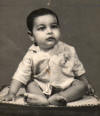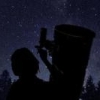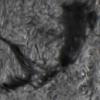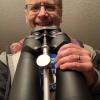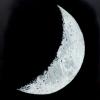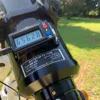
photometry questions
#1

Posted 13 January 2011 - 07:59 AM
Is there any narowband filter which may be used for cutting off the sodium lamp spectrum which is the main light poluter in my back yard so that photometery can be done, or would any type of filtering be self defeating because I do not integrate the entire spectrum coming from a star ?
I apologize if the question is dumb but I'm new to this and need to make some decisions.
#2

Posted 13 January 2011 - 09:18 AM
The answer to the filter question depends on the type of photometry you are performing. I'm not an expert so perhaps some others here will comment.
JimC
#3

Posted 13 January 2011 - 10:31 AM
It is definitely possible to do photometry from a light polluted area since you normally do use filters that exclude most light pollution (the exact filters will depend on what you are actually doing).
With a CCD camera (mono) most people use a "V" filter (the "V" stands for "visual so it is a sort of yellow-green). There are also "R" (red) and "B" (blue) filters as well as others. These are not the same as the RGB filters that are used to take "pretty pictures."
I am currently using an infrared photoelectric photometer using "H" and "J" filters-- both are in the near infrared. They are very much immune to light pollution-- I have had car headlights sweep across the telescope, outside house lights turned on, etc. all to no effect-- in fact, I could do it from a mall parking lot and would have no issues.
Tom
#4

Posted 13 January 2011 - 11:00 AM
I think this is SO cool!
#5

Posted 13 January 2011 - 11:18 AM
You can even do unfiltered photometric observations from light polluted area. It's all about how bright your target is.
Clear skies, Hubert
http://www.vvs.be/wg/wvs/
#6

Posted 13 January 2011 - 03:34 PM
that's very encouraging.
What is the IR photometer you are using and at what wavelength does it have peak sensitivity ?
I thought that most infrared is absorbed by water vapor and other junk in the atmosphere.
What type of observations do you do in IR ?
Thanks
#7

Posted 13 January 2011 - 03:47 PM
the spectroscopy data from the heart of Paris is very impressive.
Thanks for pointing this out and the link.
#8

Posted 13 January 2011 - 03:55 PM
good to know. It seems that once i jump into the water I will most probably start with the brightest stars before I try very faint ones.
It Seems that for real faint targets it will make sense to select targets that show very fast variability so that one can do some work from a few hours at a dark site and still get some meaningful data.
slower brighter targets will probably best be done from my home which is more light polluted but I will be able to collect more data at higher collection rate (more nights).
#9

Posted 13 January 2011 - 05:51 PM
Have fun!
#10

Posted 13 January 2011 - 08:23 PM
The photometer is an Optec SSP-4. It comes with two filters, H and J. Peak response is around 1250nm (J) with still good sensitivity at around 1650nm (H).
You're right about the water vapor-- it stops most IR, but these two wavelengths (and a few others) can sort of get through-- they are not immune, though. I have to keep an eye on the water vapor maps and fog or high cirrus will put a stop to the photometry.
You also need as large a telescope as possible-- I'm working with an 8-inch SCT and its almost too small (I've also used a C14 and its much better :-)). I am restricted to bright IR targets (about mag. 2.5 and brighter). Fortunately, there are lots of IR bright stars out there-- R Lyrae is faint visually, in the IR it shines at mag. -2.
Tom
#11

Posted 14 January 2011 - 07:50 AM
Thanks for the details.
Did you start doing IR photometry because your favorite targets were bright in IR, or for other reasons ?
#12

Posted 14 January 2011 - 12:35 PM
You don't have to choose faint stars with fast variability. There are plenty bright stars (7 - 10 mag) with periods ranging from 2 till 4 hours.
Clear skies, Hubert
http://www.vvs.be/wg/wvs/
#13

Posted 14 January 2011 - 03:54 PM
Another bonus, at least for me, is that very few other people (amateurs, at least) are doing this. I appear to be the only person submitting H and J data to the AAVSO on Eps Aur-- there are probably other people doing it, but they're sitting on their data, probably so that papers can be written from it.
Tom
#14

Posted 15 January 2011 - 04:14 AM
Thanks, thats good to know.
I dont really know much about variable stars and photometry.
I am basically just researching my options before I buy any specific equipment.
While I may have the patience to do objects which have long periodicity, I just thought that it may be more prudent and stimulating initially to start with objects which can give results within a period of hours or days, so that I can get exposed to the entire data acquisition, reduction and processing and plotting within a short time so I can get a better notion of what this is all about.
#15

Posted 15 January 2011 - 01:27 PM
but it's in dutch. Maybe you can let it translate by google or something. I think it's better that I make a English version to put in on our English section of the website. Anyway, its' a project that were are running in our Belgium variable star section and every year we make a publication as an IBVS.
There are some bright stars in the 8 - 10 mag range and you can see that a lot of them have periods of 1.5 - 3 hours. Perfect for a short night.
Clear skies, Hubert
http://www.vvs.be/wg/wvs/
#16

Posted 15 January 2011 - 02:59 PM
Fun stuff.
#17

Posted 16 January 2011 - 05:43 AM
Thanks for the tip - I may try the google translation but I dont have good experience with it (at least not on German and Japanese).
I think after I figure our what projects I want to do It would be possible to better focus on what equipment I need.
I think currently the weakest link in my equipment chain is the mount (Atlas EQG). I may be able to get away using a 8" scope with Imaging gear on it but it definitely would not be good with my 40 pound 12" LX200R OTA +Camera on it.
If I get a good mount I may not have enough $ left for a good camera.
I am still looking for the best solution (If I stay with the Atlas mount I would be restricted to a lighter OTA - I was thinking about maybe a 8" AT8RC with Carbon Fiber OTA which may be light enough to sit confortably on my Atlas.
I was wondering if my FSQ106 refractor being a widefield 4" will be good enough for this kind of work - I have both the focal reducer and the focal extender for it so I can have three different focal lengths to select from (if so I would only have to buy the CCD so I can start working on this.
#18

Posted 16 January 2011 - 05:53 AM
Thanks for sharing your experience.
I understand your reasons for choosing long period variables. If you observe regularly and have an ongoing program it does make a lot of sense to operate as you do.
Cataclismic variable sound exciting - are there any good ones with brighter baseline magnitudes such as 8-10 ?
Thanks
#19

Posted 16 January 2011 - 08:16 AM
I use a C8 on a EQ6 with a SBIG ST7. Works very good for me.
A 4" refractor will also do the job. Very soon I'm going to do tests with a 10 cm refractor equipped with a DSLR.
Clear skies, Hubert
http://www.vvs.be/wg/wvs/
#20

Posted 16 January 2011 - 08:18 AM
SS Cyg, R Gem, RX And, RU Peg ....
#21

Posted 16 January 2011 - 09:15 AM
Concerning your equipment, one of the nice things about photometry is that the image quality is not as critical as if you taking a "pretty picture." It doesn't matter if your star images are smeared out over a few pixels (in fact, that is what you want-- you don't want the image of a star to be so tightly focused and tracked that its light falls onto a single pixel).
Go ahead and try what you have, you may be surprised at how well it does. I have a friend who carries a C14 with on his Atlas and it does really well-- it is a visual only set up, but I'm really impressed with how well it works.
Tom
#22

Posted 16 January 2011 - 09:47 AM
Thanks for this comment. I didn't know that you can do photometry with less well focused images. That seems very interesting.
I have used my 12"LX200R to visually observe with my Atlas and it works real fine (if there is no wind). So I already know that the Atlas can take the weight. What I did not know was that you do not need perfect tracking for photometery.
I have a (non-cooled) Meade DSI IIPro CCD camera. Do you Think I can use it for photometry ? I have no way of controlling its temperature so any temperature changes during an observing session may change the pixel response to light. (however, I may be able to build a Temperature regulating enclosure for it).
If it is not usable - what would be a good starting level CCD camera for work with the 12" LX200R F/10 on an Atlas something which can yield Science grade S/N levels and can be gotten used for a reasonable price.
#23

Posted 16 January 2011 - 10:01 AM
Thanks, this is great. I also have an Explore Scientific 127ED triplet refractor (5"). I may give it a try on the Atlas.
Now all I have to do is get me a decent Camera.
By the Way, If you are going to be using a DSLR, How are you going to get the data for the relevant pixels from the Raw File ? can you actually know the light intensity from the Raw file, or are you going to be visually comparing it to comparison or calibration stars visually from the ficture ?
How would you know that the CCD of the DSLR does not heat up during use ? and how are you going to deal with pixel sensitivity changes during the night.
I have a Canon 40D - thats why I am interested to know how you are going to do photometry with a DSLR - because if it is possible, then I already have all the equipment that I need for starting.
#24

Posted 16 January 2011 - 10:06 AM
Is there a single high level text for photometry that can be used by a newbie but is very concise and at the same time practical ? I have no problem with graduate level math and I am not afraid of technical language and/or equations.
What should i buy or download ?
Thanks
#25

Posted 16 January 2011 - 10:20 AM
http://www.willbell.com/aip/index.htm
I would be interested in others responses to this question as well.
JimC










